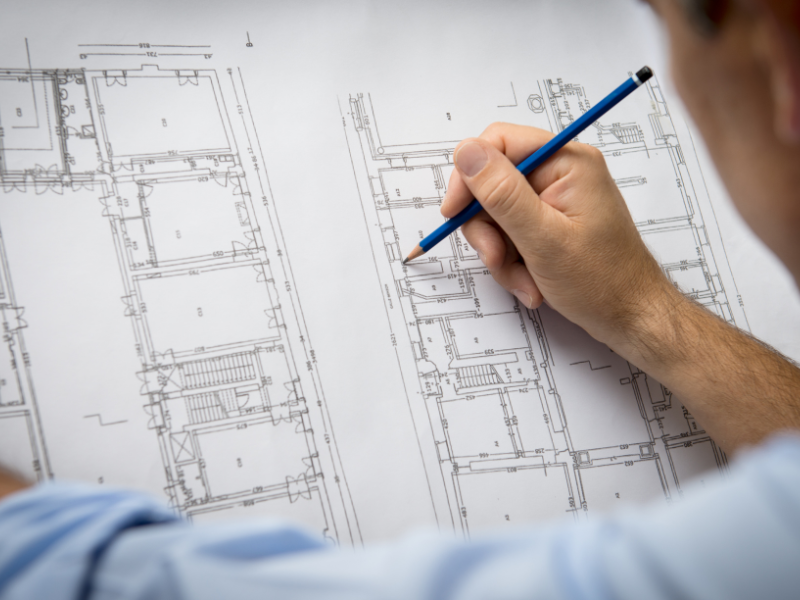Architect Tips for Designing Current Residential Spaces
Wiki Article
Comprehending the Diverse Profession Paths Available for Aspiring Architect
As an ambitious Architect, you have a world of career paths awaiting you. Each path offers unique challenges and possibilities to apply your creativity and technical expertise. Whether you're attracted to conventional style or the subtleties of lasting style, there's a particular niche that aligns with your passions. Comprehending these diverse choices can shape your specialist journey, however which instructions will you pick to explore first?Traditional Architecture: Designing Structures and Frameworks
Typical design concentrates on making buildings and structures that blend functionality with aesthetic appeal. Your styles can reflect social heritage, showcasing neighborhood traditions while satisfying contemporary demands.You'll develop abilities in composing, model-making, and website analysis, enabling you to visualize and interact your ideas successfully. Engaging with customers, you'll need to recognize their vision and convert it right into possible designs.
Additionally, developing codes and sustainability methods are crucial in your job, guaranteeing your frameworks are ecologically friendly and secure. As you expand in your profession, you'll find chances in household, industrial, or also restoration tasks, each offering one-of-a-kind difficulties. Embracing traditional style leads the way for a fulfilling profession that pays homage to the past while shaping the future.
Urban Planning: Forming Neighborhoods and Public Spaces
As a hopeful Architect, you can play a necessary function as a metropolitan planner, transforming just how neighborhoods function and interact. By employing area engagement strategies, you'll guarantee that residents have a voice fit their setting. Plus, integrating sustainable style concepts will certainly aid create areas that not only satisfy today's needs however likewise safeguard the future.Duty of Urban Planners
While numerous might believe of designers as the single visionaries behind structures, metropolitan planners play an essential role in shaping the wider landscape of communities and public rooms. By collaborating with numerous stakeholders, you'll assist design parks, transport systems, and residential areas that promote social communication and accessibility. Your experience in spatial style and community dynamics enables you to picture future development while preserving cultural heritage.Community Interaction Strategies
Reliable area involvement methods are essential for metropolitan coordinators to guarantee that the voices of homeowners are listened to and valued in the planning process. To cultivate significant discussion, you need to focus on open forums and workshops where neighborhood members can express their concepts and issues. Usage studies and social media to get to a broader target market, making sure varied point of views are consisted of. Collaborating with local companies can boost depend on and help with much deeper links. It's crucial to supply clear information concerning decision-making processes and proposed projects, enabling citizens to really feel informed and equipped. By actively paying attention and integrating feedback, you'll produce rooms that reflect the community's requirements, ultimately resulting in more sustainable and successful city environments. Welcome openness and constant discussion for long-term influence.Sustainable Layout Principles
When creating city spaces, including sustainable layout concepts is important for producing atmospheres that flourish both environmentally and socially. You must start by focusing on energy performance, using materials that reduce waste and advertise recycling. Take into consideration incorporating eco-friendly rooms, like parks and yards, to enhance biodiversity and boost air top quality. Advertising walkability and public transportation can reduce reliance on cars, cultivating a healthier area.Designing with water conservation in mind is likewise crucial-- consider rainfall gardens and absorptive surfaces to handle stormwater. Involving area participants throughout the planning procedure guarantees that the areas you create meet their demands and motivate social communication. By embracing these concepts, you'll add to dynamic, lasting urban landscapes that profit everyone.

Landscape Architecture: Developing Lasting Outside Settings
As you check out landscape architecture, you'll discover crucial style concepts that produce useful and stunning outdoor spaces. Lasting methods play an important duty in guaranteeing these atmospheres flourish while minimizing ecological impact. And also, you'll find a variety of job chances that permit you to make a genuine distinction in exactly how individuals engage with nature.Style Principles in Landscape
Comprehending style concepts in landscape architecture is necessary for developing lasting outside environments that balance with nature. You'll need to consider components like equilibrium, range, and proportion to ensure your layouts feel natural and welcoming. Integrating indigenous plants not just enhances biodiversity yet likewise lowers water usage, making your landscape resilient. Consider the flow of area and just how individuals interact with it; pathways and seating areas need to welcome exploration and relaxation. Furthermore, focus on seasonal modifications, developing with materials that enhance the surroundings year-round (Architect). By focusing on sustainability and appearances, you can create outdoor spaces that enhance the neighborhood and promote wellness. Welcoming these concepts will certainly establish a solid foundation for your profession in landscape design.Lasting Practices Summary
Sustainable practices in landscape style not just focus on aesthetic appeals however also focus on environmental health and wellness and resource preservation. By integrating native plants, you boost biodiversity and minimize the need for chemical plant foods and chemicals. Executing efficient watering systems helps conserve water and lessens runoff, protecting neighboring environments. You can design rooms that promote dirt health and wellness, such as practicing and making use of organic materials permaculture concepts. Additionally, including green framework, like rain yards and porous sidewalks, aids in stormwater administration and reduces metropolitan heat. When you produce exterior atmospheres with sustainability in mind, you add to a healthier earth and provide areas that foster neighborhood link. Ultimately, these methods assure your designs benefit both individuals and the atmosphere for try these out several years to come.Career Opportunities Exploration
With a strong structure in lasting practices, landscape architecture supplies a range of career courses that enable you to make a purposeful influence on the atmosphere. Urban planners often team up with landscape designers to develop eco-friendly spaces in metropolitan settings, boosting city livability. If you're passionate concerning education, take into consideration ending up being a landscape architecture instructor, inspiring future generations.Lasting Design: Concentrating on Eco-Friendly Practices
As you explore your occupation in architecture, accepting environmentally friendly techniques can set you apart in an affordable field. Sustainable layout concentrates on producing structures that reduce ecological impact while improving owner wellness. By including renewable her comment is here materials, energy-efficient systems, and lasting structure techniques, you'll add to a greener future.Beginning by gaining understanding of environment-friendly certifications like LEED or BREEAM, which can boost your qualifications. Consider exactly how all-natural light, air flow, and thermal efficiency can enhance style. Team up with designers and environmental specialists to innovate options that lower waste and conserve resources.
Don't fail to remember the relevance of community participation-- engaging local stakeholders can influence layouts that balance with the atmosphere. As customers increasingly prioritize sustainability, your expertise in environmentally friendly methods will not only draw in jobs however likewise meet your enthusiasm for accountable design. Accept this critical element of the profession, and watch your career flourish.
Historic Preservation: Protecting and Recovering Social Heritage
While you start on your building journey, think about the vital function of historic preservation in keeping our social heritage. This area focuses on the protection and remediation of significant buildings, websites, and frameworks that tell the stories of our past. By participating in historical preservation, you'll help safeguard the building tradition that shapes area identification.As a historical preservation Architect, you'll examine historical significance and examine the condition of frameworks. You'll work very closely with historians and preservationists to ensure authentic repair techniques are utilized. This career course allows you to mix creativity with research study, enabling you to create solutions that appreciate initial materials and workmanship.
Your work not only adds to sustainability by reusing existing structures but likewise cultivates a feeling of satisfaction within communities. Accepting this course will help you end up being a guardian of background, preserving the tales and looks that enrich our lives.
Interior Design: Enhancing Indoor Spaces
Historical preservation and interior style both share a dedication to enhancing the developed setting, but they focus on different elements. While historical preservation emphasizes preserving a framework's social and historical worth, indoor style zeroes in on optimizing indoor areas for capability and visual appeals.As a hopeful Architect, you'll discover that indoor style permits you to mix creativity with technical skills. You'll create areas that not just look excellent yet additionally advertise convenience and efficiency. This field involves understanding how light, color, and materials communicate within a space, affecting mood and usability.
You'll deal with various jobs, from property homes to industrial offices, making sure that each atmosphere satisfies the requirements of its passengers. By focusing on individual experience, you can transform interiors into inspiring and functional rooms, making a significant effect on how people interact with their surroundings. Welcome the possibility to boost indoor atmospheres and shape the means people function and live.
Industrial Style: Combining Functionality With Appearances
Commercial design plays an essential duty in developing items that seamlessly mix visual appeals with functionality, making sure that what you utilize daily is not only aesthetically enticing yet also useful. As a hopeful Architect, you can engage on your own in this area, focusing on developing every little thing from furniture to consumer electronics. Your job entails understanding user needs, materials, and producing processes, allowing you to create ingenious options that improve everyday experiences.In commercial layout, you'll usually work together with marketing professionals, engineers, and manufacturers, making certain basics that your layouts are not only beautiful but additionally viable. This job course provides a dynamic environment where creative thinking satisfies functionality, making it a gratifying choice for engineers interested in shaping the products of tomorrow.
Regularly Asked Inquiries
What Educational Accreditations Do I Need to Come To Be an Engineer?
To end up being an architect, you'll require an expert degree in style, commonly a Bachelor's or Master's. Furthermore, you'll have to finish an internship and pass the Architect Registration Examination to exercise legally.Exist Certification Needs for Different Architectural Occupation Paths?
Yes, there're certification needs for different building paths. Architect. You'll require to pass examinations, full internships, and in some cases pursue specialized training, depending on your chosen focus, like landscape style, city layout, or historical conservationWhat Software Skills Are Vital for Designers Today?

Just How Can I Gain Practical Experience While Examining Design?
You can gain useful experience by interning at architectural companies, joining style competitions, offering for community projects, or teaming up with schoolmates on real-world projects. These opportunities boost your abilities and develop important connections in the industry.What Job Opportunities Exist Outdoors Standard Style Firms?
You can check out various work chances outside conventional architecture companies, like urban preparation, interior decoration, landscape design, construction management, realty development, and even functions in sustainability consulting. Each deals one-of-a-kind obstacles and benefits.Whether you're drawn to conventional design or the nuances of sustainable layout, there's a particular niche that straightens with your rate of interests.When developing city areas, incorporating lasting style principles is vital for developing environments that flourish both environmentally and socially.As you discover landscape style, you'll discover important style concepts that produce attractive and functional outside areas.Recognizing design principles in landscape architecture is vital for producing lasting outside atmospheres that integrate with nature.In industrial design, you'll frequently work together with marketing experts, designers, and suppliers, ensuring that your layouts are not just attractive yet likewise practical.
Report this wiki page